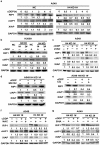Histone H4 expression is cooperatively maintained by IKKβ and Akt1 which attenuates cisplatin-induced apoptosis through the DNA-PK/RIP1/IAPs signaling cascade
- PMID: 28139737
- PMCID: PMC5282510
- DOI: 10.1038/srep41715
Histone H4 expression is cooperatively maintained by IKKβ and Akt1 which attenuates cisplatin-induced apoptosis through the DNA-PK/RIP1/IAPs signaling cascade
Abstract
While chromatin remodeling mediated by post-translational modification of histone is extensively studied in carcinogenesis and cancer cell's response to chemotherapy and radiotherapy, little is known about the role of histone expression in chemoresistance. Here we report a novel chemoresistance mechanism involving histone H4 expression. Extended from our previous studies showing that concurrent blockage of the NF-κB and Akt signaling pathways sensitizes lung cancer cells to cisplatin-induced apoptosis, we for the first time found that knockdown of Akt1 and the NF-κB-activating kinase IKKβ cooperatively downregulated histone H4 expression, which increased cisplatin-induced apoptosis in lung cancer cells. The enhanced cisplatin cytotoxicity in histone H4 knockdown cells was associated with proteasomal degradation of RIP1, accumulation of cellular ROS and degradation of IAPs (cIAP1 and XIAP). The cisplatin-induced DNA-PK activation was suppressed in histone H4 knockdown cells, and inhibiting DNA-PK reduced expression of RIP1 and IAPs in cisplatin-treated cells. These results establish a novel mechanism by which NF-κB and Akt contribute to chemoresistance involving a signaling pathway consisting of histone H4, DNA-PK, RIP1 and IAPs that attenuates ROS-mediated apoptosis, and targeting this pathway may improve the anticancer efficacy of platinum-based chemotherapy.
Conflict of interest statement
The authors declare no competing financial interests.
Figures






Similar articles
-
Concurrent blockade of NF-κB and Akt pathways potentiates cisplatin's antitumor activity in vivo.Anticancer Drugs. 2012 Nov;23(10):1039-46. doi: 10.1097/CAD.0b013e32835679b8. Anticancer Drugs. 2012. PMID: 22760211
-
Retaining MKP1 expression and attenuating JNK-mediated apoptosis by RIP1 for cisplatin resistance through miR-940 inhibition.Oncotarget. 2014 Mar 15;5(5):1304-14. doi: 10.18632/oncotarget.1798. Oncotarget. 2014. PMID: 24675421 Free PMC article.
-
DNA-PKcs deficiency sensitizes the human hepatoma HepG2 cells to cisplatin and 5-fluorouracil through suppression of the PI3K/Akt/NF-κB pathway.Mol Cell Biochem. 2015 Jan;399(1-2):269-78. doi: 10.1007/s11010-014-2253-6. Epub 2014 Oct 28. Mol Cell Biochem. 2015. PMID: 25348361
-
Receptor-interacting protein 1 increases chemoresistance by maintaining inhibitor of apoptosis protein levels and reducing reactive oxygen species through a microRNA-146a-mediated catalase pathway.J Biol Chem. 2014 Feb 28;289(9):5654-63. doi: 10.1074/jbc.M113.526152. Epub 2014 Jan 14. J Biol Chem. 2014. PMID: 24425875 Free PMC article.
-
TRAIL activates JNK and NF-κB through RIP1-dependent and -independent pathways.Cell Signal. 2015 Feb;27(2):306-14. doi: 10.1016/j.cellsig.2014.11.014. Epub 2014 Nov 18. Cell Signal. 2015. PMID: 25446254 Free PMC article.
Cited by
-
Reversible Histone Modifications Contribute to the Frozen and Thawed Recovery States of Wood Frog Brains.Biomolecules. 2024 Jul 12;14(7):839. doi: 10.3390/biom14070839. Biomolecules. 2024. PMID: 39062553 Free PMC article.
-
Comparative Review on Cancer Pathology from Aberrant Histone Chaperone Activity.Int J Mol Sci. 2024 Jun 10;25(12):6403. doi: 10.3390/ijms25126403. Int J Mol Sci. 2024. PMID: 38928110 Free PMC article. Review.
-
ORFV infection enhances CXCL16 secretion and causes oncolysis of lung cancer cells through immunogenic apoptosis.Front Cell Infect Microbiol. 2022 Jul 25;12:910466. doi: 10.3389/fcimb.2022.910466. eCollection 2022. Front Cell Infect Microbiol. 2022. PMID: 35959371 Free PMC article.
-
RIP1 promotes proliferation through G2/M checkpoint progression and mediates cisplatin-induced apoptosis and necroptosis in human ovarian cancer cells.Acta Pharmacol Sin. 2020 Sep;41(9):1223-1233. doi: 10.1038/s41401-019-0340-7. Epub 2020 Apr 2. Acta Pharmacol Sin. 2020. PMID: 32242118 Free PMC article.
-
Autophagy and necroptosis in cisplatin-induced acute kidney injury: Recent advances regarding their role and therapeutic potential.Front Pharmacol. 2023 Jan 30;14:1103062. doi: 10.3389/fphar.2023.1103062. eCollection 2023. Front Pharmacol. 2023. PMID: 36794281 Free PMC article. Review.
References
-
- Fojo T. Cancer, DNA repair mechanisms, and resistance to chemotherapy. J. Natl. Cancer Inst. 93, 1434–1436 (2001). - PubMed
-
- Aggarwal B. B. Nuclear factor-kappaB: the enemy within. Cancer Cell 6, 203–208 (2004). - PubMed
-
- Caporali S. et al.. AKT is activated in an ataxia-telangiectasia and Rad3-related-dependent manner in response to temozolomide and confers protection against drug-induced cell growth inhibition. Mol. Pharmacol. 74, 173–183 (2008). - PubMed
Publication types
MeSH terms
Substances
LinkOut - more resources
Full Text Sources
Other Literature Sources
Miscellaneous

